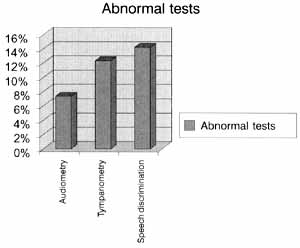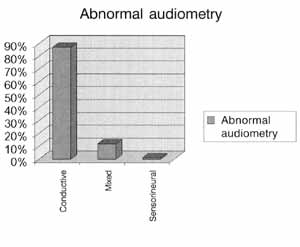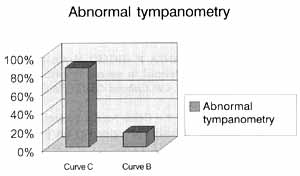

Year: 2001 Vol. 67 Ed. 4 - (5º)
Artigos Originais
Pages: 475 to 478
Audiometric and Tympanometric Findings in Asymptomatic Children.
Author(s):
Cécil C. Ramos*,
Renata R. Mendonça*,
Daniela M. Gualandro**,
Lucia E Van Onselen***.
Keywords: children, audiometry, tympanometry, logoaudiometry
Abstract:
Introduction and objectives: The authors carried out a retrospective study in audiometry of asymptomatic children, using the evaluation as a sampling of a specific population in order to determine the main audiometric and tympanometric alterations. Study design: Clinical retrospective. Patients ano methods: We carried out 211 audiometries in asymptomatic children, ranging in age from two to 10 years ano of both genders. Results: There was predominance of alterations in four to six year old children. We found audiometric alterations in 31 ears (7.34%), ano 87.09% were conductive hearing losses. Tympanometric alterations were observed in 52 ears (12.32%), with 44 type C curves (84.61%) ano 8 type B curves (15.38%). We found speech discrimination deficits in 60 ears (14.22%). Conclusions: It is possible to assume that similar results may be expected to be found in the same age range ano that tympanometry ano logoaudiometry should be used in this kind of evaluation.
![]()
INTRODUCTION
At the end of the Middle Age, thanks to Eustachius studies dated from 156315, it was already known that the auditory tube was important in the physiology of middle ear diseases. Complementary studies by Valsalva, in 1704, Deleau, 1836, and Politzer, 186315, showed the need for appropriate middle ear aeration for good functioning. However, only in this century have we seen the first studies that showed the complexity of the pathophysiology of middle ear diseases9,12,13,14. The need for early diagnosis11 of asymptomatic ear disorders became evident, especially in infants and toddlers, whose complaint or symptom becomes visible only when the process is aggravated. However, although there are a number of studies focused on providing better management to existing pathological pictures3,4,6, we found few articles in asymptomatic populations that showed the incidence of the most frequently detected affections and which are the tests that have shown to be more specific and sensitive. Therefore, through sampling study, we aimed at investigating the incidence of alterations in audiometry, tympanometry and speech discrimination tests in asymptomatic upper middle class children, defining which tests were the most sensitive ones.
MATERIAL AND METHOD
We analyzed retrospectively 211 audiometries of children aged 2 to 10 years, from an upper middle class school in the city of Santo André, state of São Paulo. Children were asymptomatic and had performed the tests before starting the school year of 2000. Parents had agreed on conducting the tests and the school principal agreed on its use in the study. Children were submitted to pure tone audiometry, speech discrimination and tympanometry. The statistical analysis of the groups was performed with chi-square test, considering p<0.05 as statistically significant.
RESULTS
The analysis concentrated on children's enrolment tests, comprising n=422 ears, both genders. In the global analysis, we observed 60 ears (14.22%) with alterations of at least one of the tests, distributed as follows: abnormal pure tone audiometry - 31 ears (7.34%); abnormal tympanometry - 52 ears (12.32%), and speech discrimination-60 ears (14.22%) (Figure 1). In abnormal pure tone audiometry, the most frequent finding was conductive hearing loss (87.09%), followed by mixed hearing loss (11.91%) and sensorineural hearing loss (1%) (Figure 2). Abnormal tympanometric tests presented predominance of type C tympanometric curve (84.61%), as opposed to type B curve (15.38%) (Figure 3). Speech discrimination was the most sensitive test, and it was abnormal in all ears that had some kind of abnormal response, either audiometric or tympanometric. In the analysis by age range, alterations were more concentrated in the age range 4 to 6 years, with significant prevalence over other age ranges. As to gender, there was a slight prevalence of males on the overall analysis (16.51 % males as opposed to 13.13% females), but the sample was not large enough to enable this kind of statistical conclusions (Figure 4).
Figure 1. Percentage distribution of abnormal tests.
Figure 2. Percentage distribution of alterations observed in pure tone audiometry.
Figure 3. Percentage distribution of tympanometric alterations.
Figure 4. Percentage distribution of abnormal tests by age range and gender.
DISCUSSION
Currently, we have noticed an increasing concern towards early diagnosis of auditory and visual problems, both by private and pubic institutions, in an attempt to minimize future problems in infants, which requires the support and encouragement of the Brazilian Society of Otorhinolaryngology. In the literature, we found studies showing this kind of assessment and the importance of early diagnosis, especially in asymptomatic children, in which we notice pathological conditions or abnormal test results that suggest clinical picture of progression5,8,9,11. Knijinik et al., in 19938, carried out a study in asymptomatic children in which they observed 16.4% of type B tympanograms, whereas we found only 1.8% of asymptomatic children with this kind of curve; the difference may be explained by distinct samples, places or time of assessment. Conversely, the fact that many children had tympanometric alterations without affecting pure tone audiometry is an observation reported by different authors5,9,11.
We also observed that although pure tone audiometry has shown to be a less sensitive test compared to tympanometry, it is the preferred test to first assess children. Speech discrimination, in our sample, proved to be the most sensitive of the three, presenting abnormal results in all cases that manifested variation from normal in the other tests. Other authors, such as Franche et al., in 19985, and Kontiokari et al., in 19989, conducted studies comparing sensitivity of the tests available for asymptomatic children assessment, concluding that tympanometry showed to be the most sensitive test, although it was not significantly better than diagnosis by otoscopy.
CONCLUSIONS
Our study has clearly shown a signifcant number of alterations in tests, leading us to the conclusion, by analogy, that a large number of asymptomatic children within this bracket of population may have hearing problems that could be treated or followed up. We have also noticed that although pure tone audiometry is the most frequently used tool for assessing pre-school children, tympanometry and speech discrimination test are more sensitive, showing the importance of reinforcing their use under such circumstances.
REFERENCES
1. BALLE, V; SEDENBERG-OLSEN, J.; THOMSEN, J.; HARTZEN, S. - Treatment of Children with secretory otitis media (SOM) with amoxicillin and clavulanic acid or penicillin -V Bacteriological finding in the nasopharynx before and after treatment. Int. J. Pediatr. Otorhinolaryngol.; 45 (1): 77-82, 1998.
2. BERMAN, S. - Otitis media in children; N. Engl. J Med., 332 (23):1560 5, 1995.
3. BOGAR, E; SANTORO, E. E.; MEDEIROS, I. R. T.; BENTO, R. F.; MARONE, S. A. M. - Otite media secretora: perfil terapêutico por uma amostra de especialistas; Rev Bras. Ootorrinolaringol; 64(2): 12735, 1998.
4. CHISKI, A.; LARENAS, J.; FELDMAN, R. - Etiologia, diagnostico y tratamiento de la otitis media secretora: um estudio prospectivo de 14 anos; Ann. Otorrinolaringol. Mex., 38(1): 19-22, 1993.
5. FRANCHE, G. L. S.; TABAJARA, L. M. V; ARRARTE, J. L. F.; SAFFER, M. - Otoscopia a timpanometria no diagnostico de otite media secretora; J Pediatr (Rio de J) 74 (5): 365-7, 1998.
6. HUNGRIA, H. - Otite media serosa-secretora; Folha MM, 91 (5-6): 375- 80, 1985.
7. KITCHENS, G. G. - Relationship of environmental tobacco smoke to otitis media in young children; Laryngoscope, 105 (5pt2 su69): 1-13, 1995.
8. KNIJNIK, D.; VANIN, G.; DURO, M. E. E; CANTERJI, M. B. - Pressão negativa do ouvido médio em escolares; Revi AMRIGS; 37 (2): 813, 1993.
9. KONTIOKARI, T.; NIEMELA, M.; UHARI, M. - Middle ear effusion among children diagnosed and treated actively for acute otitis media; Eur J. Pediatr; 157 (9): 731-4, 1998.
10. ROARK, R.; PETROFSKI, J.; BERSON, E.; BERMAN, S. - Practice variations among pediatricians and family physicians in the management of otitis media; Arch. Pediatr Adolesc. Med.. 149 (8): 839-44. 1995.
11. SAFFER, M.; OLIVEIRA FILHO, E. A.; ERCIO, A.; SAFFER, M.; NUNES, M. N. S. - Historia familiar a escolar em crianças com otite media secretora; J. Pediatr (Rio de J.); 64 (3): 71- 4, 1988.
12. SALINAS, V; EMPARANZA, P; GIGLIO, M; CAMPOS, E Bacteriology of the Adenoid in secretory otitis media. Revis. Otorrinolaringol. Cir. Cabeza Cuello, 50 (3):101-6, 1990.
13. SHUBICH NEIMAN I - Otitis media (secretora) con derrame y alergia. Estudio prospectivo en pediatria. Alergia Mex., 45 (5): 119-21, 1998.
14. SPREMO, S.; MARKI, Z.; KURBALIJA - Clinical importance of tympanometry in the diagnosis of chronic secretory otitis. Srp, Arh, Celok Lek, 126 (7-8): 242-7, 1998. 15. STANGERUP, S. E. - Autoinflation: historical highlights and clinical implication. Ear nose throat J., 77 (9): 734, 740-2, 1998.
16. SUZUKI, M.; KERAKAWAUCHI, H.; KAWAUCHI, H.; MOGI, G. - Efficacy of an antiallergic drug on otitis media with effusion in association with allergic rhinitis. An experimental study; Ann. Otol. Rhinol. Laryngol.; 108 (6): 554-8. 1999.
* Otorhinolaryngologist, FMUSP-Doctorate studies under course, Faculdade de Medicina, USP
** Undergraduate, School of Medicine, Fundação ABC.
*** Professor, Department of Pediatrics, School of Medicine, Fundação ABC.
Study conducted at Hospital Maternidade Cristovão da Gama - Santo André; approved by the Ethics Committee of School of Medicine, Fundação ABC.
Study presented at 35° Congresso Brasileiro de Otorrinolaringologia, held on October 18, 2001, in Natal/RN.
Address correspondence to: Cécil Cordeiro Ramos - Rua Gamboa 245 - 09190-670 Santo André/SP
Tel: (55 11) 4993-3794-E-mail: cecil@canbrasnet.com.br
Article submitted on January 15. 2001. Article accepted on April 12, 2001.



